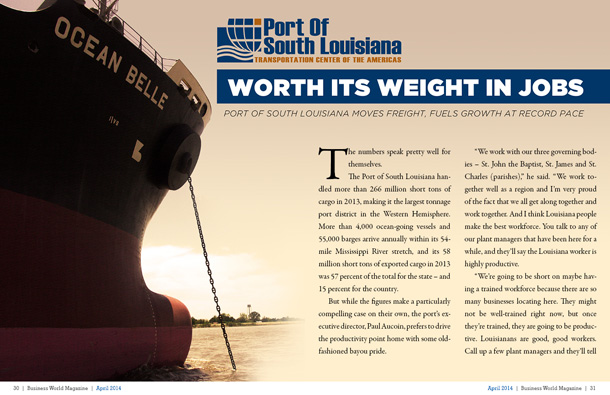
Worth its Weight in Jobs
Port of South Louisiana moves freight, fuels growth at record pace

The numbers speak pretty well for themselves.
The Port of South Louisiana handled more than 266 million short tons of cargo in 2013, making it the largest tonnage port district in the Western Hemisphere. More than 4,000 ocean-going vessels and 55,000 barges arrive annually within its 54-mile Mississippi River stretch, and its 58 million short tons of exported cargo in 2013 was 57 percent of the total for the state – and 15 percent for the country.
But while the figures make a particularly compelling case on their own, the port’s executive director, Paul Aucoin, prefers to drive the productivity point home with some old-fashioned bayou pride.
“We work with our three governing bodies – St. John the Baptist, St. James and St. Charles (parishes),†he said. “We work together well as a region and I’m very proud of the fact that we all get along together and work together. And I think Louisiana people make the best workforce. You talk to any of our plant managers that have been here for a while, and they’ll say the Louisiana worker is highly productive.
“We’re going to be short on maybe having a trained workforce because there are so many businesses locating here. They might not be well-trained right now, but once they’re trained, they are going to be productive. Louisianans are good, good workers. Call up a few plant managers and they’ll tell you that.â€
The port is governed by a seven-commissioner board that’s responsible for the oversight of owned facilities, ranging from grain elevators and general cargo facilities, which are leased out to operating companies like Archer Daniels Midland and Occidental Chemical. Additionally, the on-site Global Intermodal Terminal, a 335-acre maritime industrial park purchased by the port in 1992 is being continuously repurposed to provide handling and storage for bulk, break bulk and containerized cargo.
The overall redevelopment of the terminal, whose land had previously been home to a sugar-refining complex, is sketched out by a master plan compiled with input from shippers and manufacturers, with a specific eye toward modern needs of those entities for connectivity, efficiency and flexibility.
“It’s been a normal, gradual evolution,†Aucoin said.
“We started in the 1960s and grew into what we are today. Now, we’re huge and we play an important part, not only in our region and our state, but also in the U.S. and the world.â€
Port of South Louisiana’s headquarters is located six miles from the port’s riverside property (Globalplex), though Aucoin said one of his short-term goals is to get funding from the state to build an
on-site structure that would unite the port’s staff of 70 under one roof. Several more employees are hired by the port on a contract basis for various tasks, and each of the companies with operations within the port’s jurisdiction has its own complement of workers.
In addition to assorted day-to-day duties, a sizable part of Aucoin’s role revolves around attracting new businesses and industries to the facility, and his arsenal of incentives includes provision of tax-free bonds, assistance in building docks, security and fire protection – the port operates three fire/rescue boats up and down its section of the river – and general caretaking for the tenant companies.
“We’ve got prospects coming in every week because of the low price of natural gas and the sites that we still have available within our district right on the Mississippi River,†he said. “That’s highly attractive with the state incentives, the river and the low price of natural gas. We’re seeing the biggest boom that we’ve seen since the ’60s.â€
Aucoin arrived as executive director about two-thirds of the way through 2013, which was a banner year for the port and included the addition of a new finger-pier, adjacent and downriver to the general cargo dock at Globalplex, that provides additional space for loading and unloading of vessels and barges. Additionally, a goal to maintain status as the largest tonnage port in the Western Hemisphere – by definition, the largest in both the state and the country, too – was also met.
And lest all the glory go to superior management skills, Aucoin is quick to cite the value of location.
“Time is money,†he said. “If we can get your product here in a decent amount of time at the lowest cost, then we become a player. And once we have that product here, whether it’s shipped in by vessel or barge, we have access to major rail lines and then we have access to the Mississippi River, so you can go from ship to barge to get it upriver, or from barge to ship to get it downriver.
“That’s vital. Getting the bulk cargo here the cheapest and fastest way, and we’re ideally situated to move that cargo from the port to wherever its final destination is, either by rail or truck. We even have an airport now that we own and operate (formerly operated by St. John the Baptist parish), and we just increased the runway to 5,000 feet to accommodate business jets.â€
Aucoin said the port fuels economic growth both by being a vehicle to help companies move cargo, and by incentivizing companies to relocate. More than $60 billion worth of projects are in the discussion stages, and, while he conceded the port won’t land all of them, it’ll do well enough to make an impact.
A research study to examine the port’s specific economic footprint is in the works as well.
Internally, and with an eye toward tenant attraction, money has been earmarked to upgrade the port’s three existing warehouse facilities, and an application has been made to the state for funding to build a new $12 million warehouse for one of the existing tenants with plans to expand their operations.
Additionally, an on-site 140,000-square-foot warehouse that had been sold to a private company was re-purchased by the port and will be available to interested lease tenants within the next few months.
“You’re talking about jobs – and that’s economic growth,†he said. “We’re an economic engine that creates jobs. We still have a lot of land left and we’re seeing that now with all the prospects that we have kicking the tires, so to speak, and looking to locate here. If we get $30 or $40 billion, that’s a whole bunch of capital expenditure that will create jobs.â€
AT A GLANCE
WHO: Port of South Louisiana
WHAT: Louisiana-based port authority with jurisdiction over a 54-mile stretch of Mississippi River shoreline
WHERE: Headquarters office in LaPlace, La.
WEBSITE: www.PortSL.com








